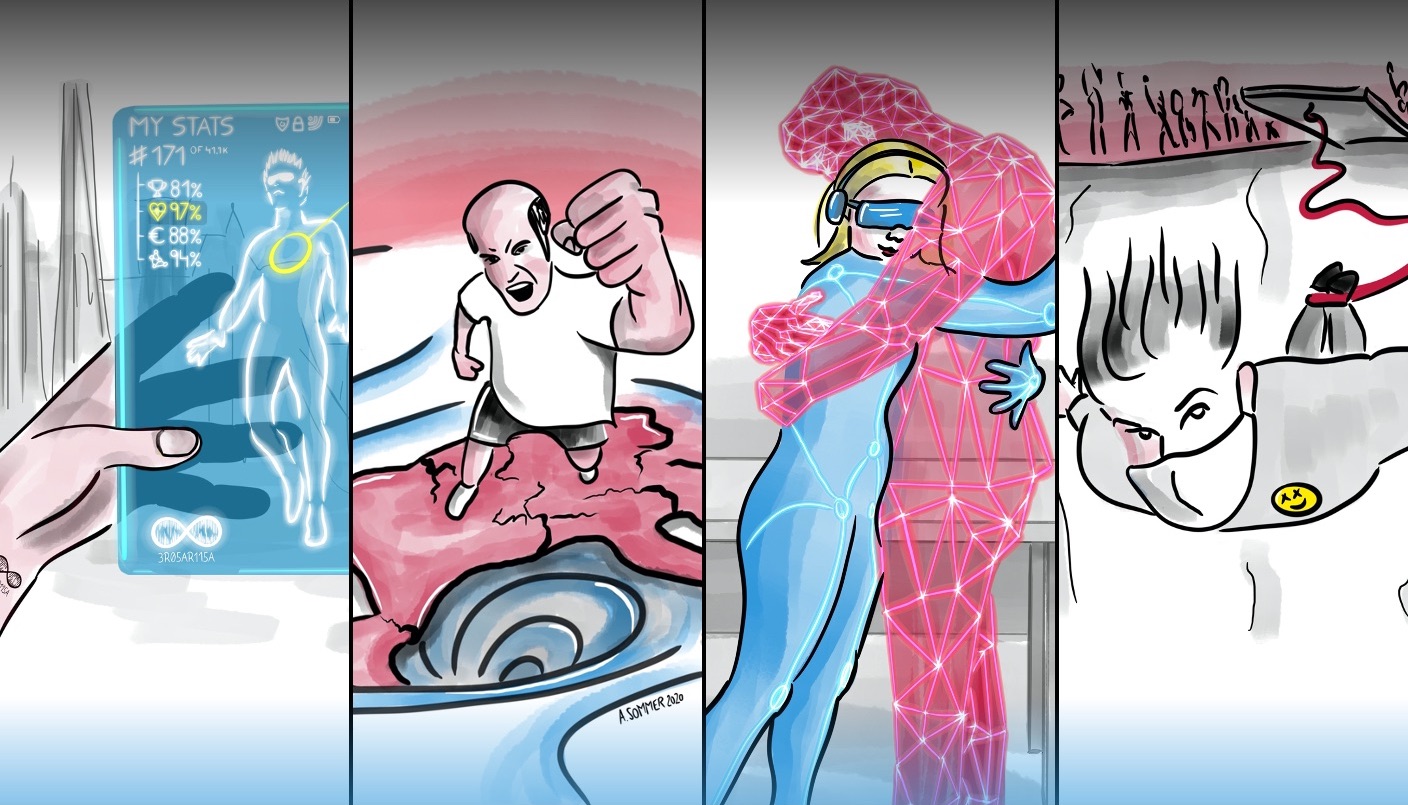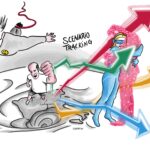April 06, 2020.
Ten years from now, we will probably still remember how we lived through the initial days and weeks of the corona crisis. Meanwhile, the world will have changed forever.
But how?
As of April 1st 2020, we can already see some short-term consequences that seemed unthinkable just a few weeks ago: Millions of people are asked – or forced – to stay at home. Restaurants and shops are closed. Inner cities that are usually bustling with life seem deserted. Pictures of the suffering caused by COVID-19 are hard to bear. Doctors are facing impossible choices as ventilators run short in certain places. To fight the virus, some demand drastic measures, including large-scale surveillance of citizens in order to “flatten the curve” of new infections. Others warn that we must not sacrifice the economy which people’s livelihoods depend on. At the same time, we see unknown levels of solidarity happening. But we also see fear and hoarding of food and toilet paper. And next week may be different again…
Countries, states and communities are currently reacting in different ways to the crisis. Time will tell which responses were effective and which were not. With this article and our four scenarios for the year 2030, however, we do not intend to answer what should or should not be done now to fight the coronavirus. Instead, we try to shed some light on the potential long-term consequences of the actions that we take today.
Complex social systems like the economy, or society as a whole, share an important characteristic: Even decisions that seem inconsequential at first can – in certain cases – have immense impacts in the long run. One illustrative example of so-called path dependence is left- vs. right-hand traffic: When automobiles first came up, it would still have been relatively easy to switch countries to one side of the road globally. Today, this would be far more difficult and costly (the last European country to switch was Sweden: at 4:50 am on September 3, 1967, all cars had to stop. At 5:00 am they were allowed continue – on the right side of the road. [1]). During a crisis, many decisions are taken in the heat of the moment. “Act now – discuss later!” is an often-used argument. However, as Yuval Noah Harari warned in a recent ft.com article with respect to surveillance for public health reasons: “… temporary measures have a nasty habit of outlasting emergencies, especially as there is always a new emergency lurking on the horizon.” [2]. The remedy of today may become the curse of tomorrow. Conversely, we will live in a better future if we set the right course now. Scenarios help us identify these key choices that may be significant for the next ten years and beyond – for our health, our economy, our society.
At the crossroads – scenarios as a guide into the future
Scenarios provide us with a glimpse on how the future may unfold. Yet scenarios are sometimes criticized as mere intellectual exercises. Used the right way, however, they are of high practical relevancy. For companies, scenarios can be used to assess the robustness of their strategy and business models. They provide clarity on the true choices that companies are facing. Scenarios also portray possible customers of the future – what they will think, feel and need. In short, scenarios help companies to prepare against threats and inspire them to shape their future rather than just waiting for it to unfold. Governments or NGOs can benefit in a similar way.
In the following, you will find (A) short descriptions for each scenario, (B) a “historical account” of how each of the scenarios emerged from today until 2030, and (C) a comparison of representative scenario aspects to clarify how each scenario is different (note: unless specified otherwise, the scenarios describe the situation in Germany in 2030).
One last point before you explore the scenarios: It is important to keep in mind that scenarios are not “predictions” – by design, they are plausible but unlikely. The world of the year 2030 will likely feature aspects from several of our scenarios, along with things that we did not anticipate at all. To keep track of where the world is heading, watch the indicators that are representative of each scenario (e.g., the state of the economy, level of digitalization, freedom vs. security, etc.)
Our four scenarios for 2030 in a nutshell:
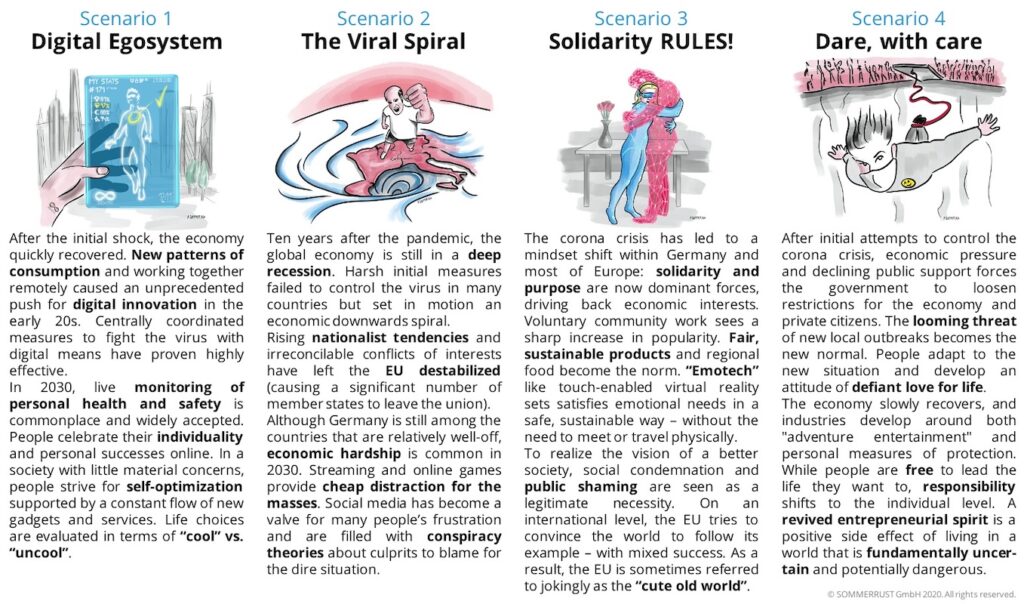
Scenarios are the endpoint of a long-term development – over 10 years in this case. At first glance, you may feel that the worlds we constructed are too radical, too different from today. To open up your mind for “scenario thinking”, it might help to remind yourself how things were 10 years ago. For example, in April 2010 the Arab Spring was yet to happen, Donald Trump was known mainly as a TV personality (with season 9 of “The Apprentice” running), and our celebrities had no followers on Instagram (that was only launched in October 2010). Scenarios are the result of trends and their interaction with outcomes of various uncertainties (in this case, we considered 31 trends and 18 uncertainties using our Scenario Sprint methodology). The storylines below describe how the world might develop from today to the respective scenarios in 2030. They are designed to help you connect the dots and immerse yourself into the future worlds that we have built for you:
Scenario 1 — “Digital Egosystem”
… how a virus triggered a digital revolution
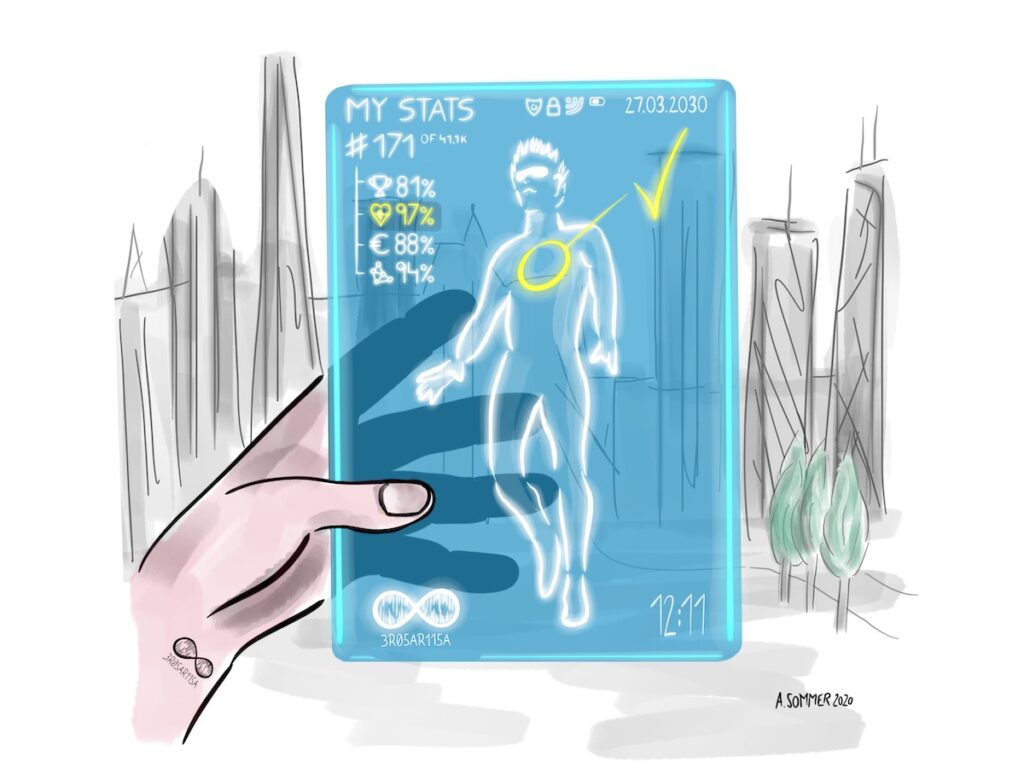
- Social distancing and working from home initially felt like a major disruption for many. As lockdowns persist, people get used to digital tools for virtual collaboration. Friends even get used to celebrating parties remotely (with a common dinner and drinks menu).
- As a consequence, entrepreneurial energy and venture capital is focused on remote tools that help people manage and enjoy their lives online.
- Meanwhile the corona crisis begins to disappear. Countries like South Korea that successfully controlled the virus through digital monitoring are considered to be best practices.
- Emergency acts to restrict certain civil liberties like privacy and freedom of movement are extended for precautionary reasons and many are never revoked.
- Bit by bit, an ever more sophisticated digital ecosystem is established: Inter alia, it promises preventing common diseases through constant health monitoring and “lifestyle nudging”. It also creates a digital twin to plan and document your education, to advance your professional careers in a booming job market, to make sensible financial provisions, and much more.
- By the year 2025, not having a comprehensive online identity is as unthinkable for many people as not having a smart phone was in 2020. More and more aspects of life get quantified and scored one way or the other, feeding people’s egos. High online scores equate with social status – rather than family origin or profession.
- By 2028, by far the most diagnosed mental illnesses are related to “virtual burnout”, account hacking, or personal crises due to disappointing own online biographies.
- In 2030 the “digital economic miracle” of the 2020s has produced millions of big digital egos and countless new billionaires – although the latter mainly in the U.S. and China.
It is important to note that scenario 1 is not created by an authoritarian state. Yes, people’s lives have become highly transparent and adverse behavior has negative personal consequences. This happens voluntarily, however, not by force. Choice by choice, people opt for security and convenience instead of autonomy and freedom. With the exception of a few dissenters, people like the society they live in and look optimistically into the future.
Scenario 2: “The Viral Spiral”
… how we lost control
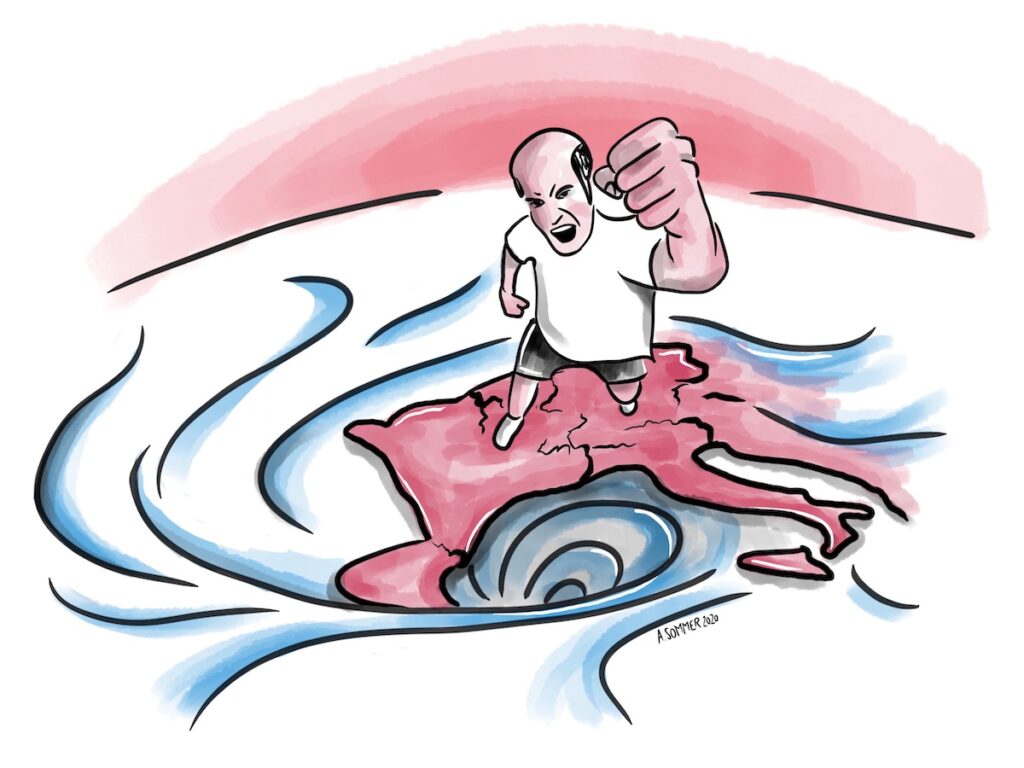
- Initial measures to fight the virus around the world were often harsh but not implemented effectively. When the virus finally seemed to be defeated after several new waves of outbreaks, it left behind a crippled global economy that was only kept alive by huge stimulus packages.
- Soon, the first scandals get uncovered: several companies and rich individuals had misappropriated state money or taken advantage of the crisis. Violent protests erupt.
- The US economy is hit particularly hard with historically high unemployment. In an attempt to protect national economic interests, the US leads the way by enacting far-reaching laws on domestic production of “systemically relevant products”. Escalating trade conflicts are the result.
- In the year 2022, COVID-22 is discovered and new lockdowns are enacted. This time, healthcare systems are better prepared but many companies that barely survived the last crisis can no longer be saved. Social systems are cut back radically to avoid national bankruptcies.
- In the political arena, the virus of populism and finger-pointing has spread. Extremist parties win one election in Europe after the other and make government formation increasingly difficult.
- Conflicts between EU member states escalate over the allocation of EU funds for struggling economies. During the so-called “EUxodus” until 2024, several EU member states have decided to leave the union.
- Deeply disappointed by their political and economic leaders, many people vent their frustration on various social media sites – the new “ghettos” of the internet.
- One of the few industries that prospers is online entertainment – movie streaming, online games, gambling, etc. By 2030, online addiction is widely considered the biggest public health issue in Germany.
Scenario 2 is a grim scenario. Of course, there are also stories of hope and benevolence. But society is deeply divided over who is to blame and what the path forward should be. Combined with a lack of trust in institutions and democratic processes, a successful turnaround seems unlikely in the near future.
Scenario 3: “Solidarity RULES!”
… a new sense of purpose is born

- Luckily, the worst case in terms of corona deaths and economic consequences has not materialized. However, prolonged social distancing and continued cautionary measures for gatherings take their toll: Many, especially younger people develop mental problems like anxiety or loneliness. With constant news about the high risk of contagion, close physical contact starts to feel threatening for an increasing number of people.
- At the same time, the desire to do good reaches a new level. “Fridays for Future” got temporarily thwarted by the crisis but is now refueled by the desire for solidarity and purpose that unites the younger generation. An even broader social movement for international solidarity and sustainability emerges.
- By the year 2023, 65% of young women and 42% of young men do voluntary service after finishing school.
- Economically, so-called “Emotech” is booming: this includes devices and apps that support psychological needs as well as remote social tools. On Christmas 2025, one of the most popular presents is a tactile virtual reality set that allows people to hug and touch each other at a distance – by wearing a special suit and goggles.
- Over time, the new zeitgeist for solidarity also takes root in the political mainstream.
- In large organizations, Corporate Social Responsibility (CSR) sees a dramatic increase in significance. Several companies suffer from boycotts and mass resignations after they violated the increasingly strict moral code of the late 2020s.
- By the year 2028, “public shaming due to a moral fail” has become the number one personal fear – ahead of “getting a fatal illness”.
- The EU has meanwhile been transformed into a “value union” that represents the new European mindset on the international stage. The biggest economic powers, the USA and China, only adopt limited aspects of the new mindset (mostly related to climate change and global sustainability). The economy is still the main priority in these regions and Europe slowly but steadily falls behind in terms of economic growth.
Most people who live in the “Solidarity RULES!” world feel positive about it (and defend it against criticism). At the same time, society does not tolerate fundamentally different lifestyles that are considered as too materialistic or selfish.
Scenario 4: “Dare, with care”
… a newfound confidence in life
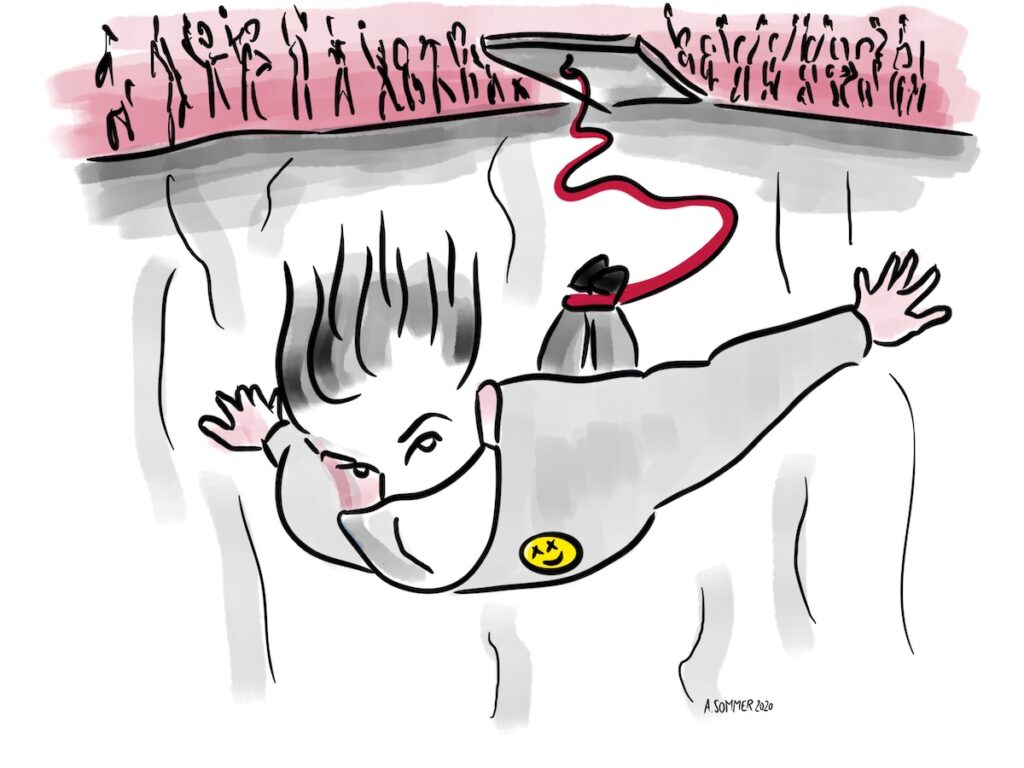
- Initial strict measures like lockdowns and company closures ease the pressure on the healthcare system. However, it soon becomes clear that upholding these measures would come at an extremely high cost in economic, social and political terms.
- As a result, measures are loosened as soon as global production of medical equipment like ventilators and facial masks has been ramped up. The coronavirus becomes a seasonal phenomenon and new cases continue to occur in significant quantities. A first vaccine becomes available in early 2021 but is not effective against certain new strains of the virus.
- The constant threat by the virus is hard to cope with for some people. However, the majority reacts by developing a new level of resilience: they are aware of the problem but accept it as a part of life. Social bonds with family and close friends regain importance.
- People quickly get used to wearing masks in public – first all the time and eventually only if sick or in busy crowds.
- At the same time, society compensates the constraints by enjoying life more consciously. People party more again, and many develop a big taste for adventure.
- Start-ups as well as established companies find innovative ways to meet the needs of “responsible adventurers”: personal protection equipment, exciting experiences, learning opportunities and DIY kits of all sorts are in high demand. Famous fashion brands incorporate protective masks and gloves in their designs to make them look stylish.
- In a survey from 2028, 80% of respondents who were 18 or older at the beginning of the crisis believe that they enjoy life more than they would without the crisis.
- In 2030, the share of people who are an entrepreneur or consider becoming one has tripled compared to ten years ago. Uncertainty is increasingly perceived as something positive – as the antidote to inertia and boredom.
“Dare, with care” is an active, resourceful society. People tend to complain relatively little and show a can-do attitude. Those who lose control over their life nevertheless can expect help for self-help – but little compassion. Apart from that, there are few legal or social rules for how people should live their lives.
Conclusion
The corona crisis has demonstrated how dynamic – and in parts fragile – the world actually is.
You may have come across the side-by-side picture of the pope announcements 2005 vs. 2013. The pictures look almost the same – with one big exception: on the second one, people are holding up countless mobile phones to take pictures. Maybe, there will soon be equally striking pictures that symbolize the new era that started with the corona crisis. For example, we may see German football fans in the stadium celebrating the FIFA World Cup of 2022 – in contrast to 2014 now all wearing facial masks (in black-red-gold).
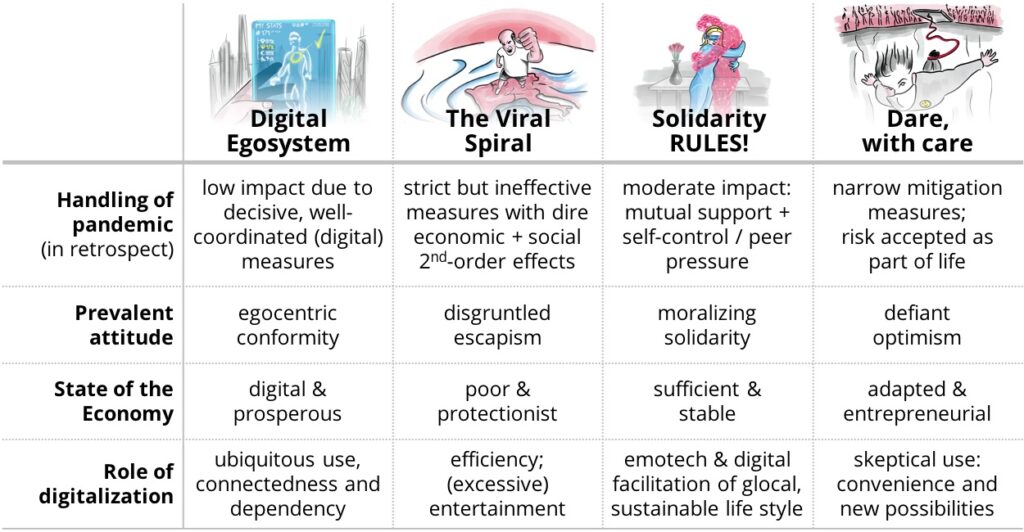
Right now, it is difficult to see anything but tragedy and danger in the crisis. However, discontinuities like this are also an opportunity to fix dysfunctional aspects of our system and make society better. But it can go either way, of course.
Our four scenarios can help us see more clearly the path we are on, and to correct it if necessary. At SOMMERRUST, we hope to make a contribution on this path by creating and facilitating innovation. Now is the time to shape the future.
Let’s get to work!
____
Sources:
[1] Wikipedia (retrieved April 1, 2020): https://en.wikipedia.org/wiki/Dagen_H. For more on path dependence see Sterman, J.D. (2000): “Business dynamics: systems thinking and modeling for a complex world”; Boston, MA et al.: McGraw-Hill, p. 349ff.
[2] Yuval Noah Harari (March 20, 2020): “Yuval Noah Harari: the world after coronavirus”, Financial Times, https://www.ft.com/content/19d90308-6858-11ea-a3c9-1fe6fedcca75
About the scenario methodology:
There are some common misunderstandings about the scenario methodology. One is that scenarios are predictions of the future. They are not. They show possibilities. Predicting the development of complex social systems over ten years is simply not feasible. Scenarios have to be plausible, but they are unlikely by design.
There are different kinds of scenarios. The scenarios described in this article are “learning scenarios”. They can be created relatively fast but do not claim to be detailed and researched deep enough to serve as “decision scenarios”. As the name “learning scenarios” implies, they are intended to start a learning process that is usually much more valuable than the scenarios itself. One of the key challenges in this respect is making sure they the scenarios are applied properly. The first step is to ensure that the audience gets a thorough understanding of the different scenario worlds (this article is one step to achieve this). Then, scenario impacts need to be determined that are specific to the audiences domain (for the scenarios above we conducted „industry sessions“ for this purpose). And finally, adequate responses need to be developed in a systematic way.
💡 Read more about our scenario methodology.
👉 How well did our scenarios anticipate what actually happened? Read our review one year later.
🔮 What would it be like to live in the four scenarios? These four short stories try to imagine an answer.
Acknowledgements:
The lead scenario building was done by Axel Sommer and Nina Kremser. The scenario building was supported internally by Frank Rust, Eva-Maria Markutzik and Marius Schmidt. A big thanks also to Eva Schneider and Steffen Sommer for their smart, creative feedback on scenario names, text and visuals. All drawings by Axel Sommer © SOMMERRUST 2020.
